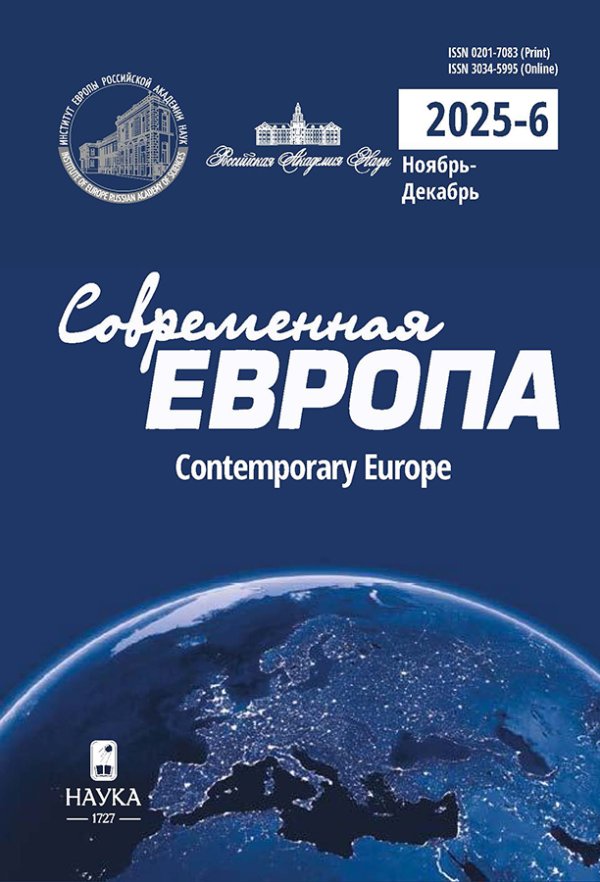Well-being of immigrants in Germany: country of origin and income convergence
- Authors: Bondarenko K.A.1, Kharitonova N.A.1
-
Affiliations:
- National Research University Higher School of Economics
- Issue: No 2 (116) (2023)
- Pages: 186-201
- Section: Articles
- URL: https://journals.rcsi.science/0201-7083/article/view/144478
- DOI: https://doi.org/10.31857/S0201708323020158
- EDN: https://elibrary.ru/OVQYEC
- ID: 144478
Cite item
Full Text
Abstract
About the authors
Ksenia Andreevna Bondarenko
National Research University Higher School of Economics
Email: xenabondarenko@gmail.com
Moscow, Russia
Natalia Alekseevna Kharitonova
National Research University Higher School of Economics
Email: nakharitonova_1@edu.hse.ru
Moscow, Russia
References
- Камкин А.К. (2015) Актуальное состояние рынка труда ФРГ и перспективы его развития. Современная Германия. Экономика и политика. Под ред. В.Б. Белова. ИЕ РАН, Издательство "Весь Мир", Москва. C. 143-158.
- Куприна Т.В. (2017) Особенности миграционных потоков стран ЕАЭС: сравнительно-сопоставительный анализ. Демографический потенциал стран ЕАЭС: VIII Уральский демографический форум. Институт экономики УрО РАН. № 2. C. 308-314.
- Пасякина Л.С. (2011) ЕС и трудовая миграция. Современная Европа. № 3. C. 100-110. DOI: http://dx.doi.org/10.15211/soveurope22020100110.
- Суринов А.Е., Луппов А.Б. (2022) Дифференциация доходов населения и стоимость жизни на субрегиональном уровне. Оценки для России. Экономический журнал ВШЭ. Т. 26. № 4. C. 552-578.
- Abdi T.A., Peiró J.M., Presti A.L. (2021) Antecedents of career success of African migrant workers in Europe: A 2011-2019 systematic literature review and future research agenda. Australian Journal of Career Development. Vol. 30. No. 3. P. 211-225. DOI: http://dx.doi.org/10.1177/10384162211066380.
- Adedeji A., Silva N., Bullinger M. (2021) Cognitive and structural social capital as predictors of quality of life for Sub-Saharan African migrants in Germany. Applied Research in Quality of Life. Vol. 16. No. 3. P. 1003-1017. DOI: https://doi.org/10.1007/s11482-019-09784-3.
- Bauer T. K., Sinning M. G. (2011) The savings behavior of temporary and permanent migrants in Germany. Journal of Population Economics. No. 24. P. 421-449.
- Becker R., Tremel P. (2006) Auswirkungen vorschulischer Kinderbetreuung auf die Bildungschancen von Migrantenkindern. Soziale Welt. Vol. 57. No. 4. P. 397-418. URL: https://www.jstor.org/stable/40878547
- Beine M., Docquier F., Özden Ç. (2011). Diasporas. Journal of Development Economics. Vol. 95. No. 1. P. 30-41.
- Bhugra D., Becker M.A. (2005) Migration, Cultural Bereavement and Cultural Identity. World Psychiatry. Vol. 4. No. 1. P. 18-24.
- Blanko L. (2004) Does Marriage after Migration Lead to Better Labor-Market Outcomes? Migraciones Internacionales. Vol. 2. No. 3. P. 173-179.
- Bobowik M., Basabe N., Páez D. (2014) Well-Being and Values of Immigrants to Spain. Encyclopedia of Quality of Life and Well-Being Research. Ed. by A.C. Michalos. Springer, Dordrecht, Netherlands. DOI: https://doi.org/10.1007/978-94-007-0753-5_3907.
- Bondarenko K.A. (2021) Labor Migration from Uzbekistan: a Family and Community Promoted Big Bang. Reg. Res.Russ. Vol. 11. P. 273-284. DOI: https://doi.org/10.1134/S2079970521020039.
- Plooy D.R., Lyons A., Kashima E.S. (2020) Social capital and the well-being of migrants to Australia: Exploring the role of generalized trust and social network resources.International Journal of Intercultural Relations. Vol. 79. P. 1-12.
- Dustmann C., Glitz A. (2011) Migration and Education. Handbook of the Economics of Education. Vol. 4. P. 327-439. DOI: https://doi.org/10.1016/B978-0-444-53444-6.00004-3.
- Fahr R. (2011) Job design and job satisfaction - empirical evidence for Germany? Management revue. Vol. 22. Issue 1. P. 28-46. DOI: https://doi.org/10.1688/1861-9908_mrev_2011_01_Fahr.
- Gruber S., Sand G. (2022) Does Migration Pay Off in Later Life? Income and Subjective Well-Being of Older Migrants in Europe. Social Indicators Research. Vol. 160. P. 969-988. DOI: https://doi.org/10.1007/s11205-020-02502-9.
- Ingwersen K., Thomsen S.L. (2021) The immigrant-native wage gap in Germany revisited. The Journal of Economic Inequality. Vol. 19(4). P. 825-854.
- Mincer J. (1994) The Production of Human Capital and the Lifecycle of Earnings: Variations on a Theme. NBER Working Papers 4838. National Bureau of Economic Research, Cambridge, USA. URL: https://www.nber.org/system/files/working_papers/w4838/w4838.pdf
- Nesterko Y., Braehler E., Grande G., Glaesmer H. (2013) Life satisfaction and health-related quality of life in immigrants and native-born Germans: the role of immigration-related factors. Quality of Life Research. Vol. 22. P. 1005-1013.
- Schaewitz J., Wang M., Rieger M.O. (2022) Culture and Institutions: Long-lasting effects of communism on risk and time preferences of individuals in Europe. Journal of Economic Behavior & Organization. Vol. 202. P. 785-829.
- Urios, A.S. (2010) Ukrainian Migration to European Union Countries: The Case of Spain. Canadian Slavonic Papers / Revue Canadienne Des Slavistes. Vol. 52(1/2). P. 153-167. URL: http://www.jstor.org/stable/40871521
Supplementary files










